


Emily Dickinson - The Game 58
 Chris Hocking went first, and presented a unique approach that would have allowed DS players to actually recreate Emily Dickinson's works by taking on the role of her Muse. His design used a formal language structure which would have distilled down her works into their component parts. These parts, then, would have been strung together into a cohesive whole to actually "write" the poem. The concepts were to have been "mined" from the real world as Emily moved about her daily business, with the player's task being to manipulate her just enough to get what they needed for the poem.
Chris Hocking went first, and presented a unique approach that would have allowed DS players to actually recreate Emily Dickinson's works by taking on the role of her Muse. His design used a formal language structure which would have distilled down her works into their component parts. These parts, then, would have been strung together into a cohesive whole to actually "write" the poem. The concepts were to have been "mined" from the real world as Emily moved about her daily business, with the player's task being to manipulate her just enough to get what they needed for the poem.
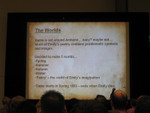 His example was that of an old willow tree, which could have been a point to collect several different concepts such as beauty or strength. Once you had all the necessary components, you'd write them together to complete the poem. As a reward, you'd be treated to a music and video reading of the work you'd completed. He specifically wanted the game to be somewhat open ended, so that the possibility of a sequel could be kept in mind. He also included some rudimentary plans for wireless integration by allowing players to send each other concepts, or to allow a look ahead by viewing another player's completed poem.
His example was that of an old willow tree, which could have been a point to collect several different concepts such as beauty or strength. Once you had all the necessary components, you'd write them together to complete the poem. As a reward, you'd be treated to a music and video reading of the work you'd completed. He specifically wanted the game to be somewhat open ended, so that the possibility of a sequel could be kept in mind. He also included some rudimentary plans for wireless integration by allowing players to send each other concepts, or to allow a look ahead by viewing another player's completed poem.
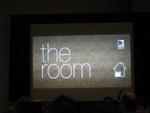 Peter Molyneux got up on stage and said "So, I went a bit overboard." He'd come prepared with an actual demo of a game, entitled "The Room". While it wasn't the crowd's favorite design it was definitely impressive. If you'd like to see part of the demo, I have some video
available, but in a nutshell the game involves using "virtual clay" to form objects inside spaces based on Dickinson's poems. Once you'd managed to make an object or alter the area to recreate the environment in which she'd written the poem, a line of the poem was read and you could move on to another object. Molyneux stated that he is dyslexic, and not very familiar with poetry, so he wanted to give a hands on feel to what could have otherwise been a pie in the sky idea.
Peter Molyneux got up on stage and said "So, I went a bit overboard." He'd come prepared with an actual demo of a game, entitled "The Room". While it wasn't the crowd's favorite design it was definitely impressive. If you'd like to see part of the demo, I have some video
available, but in a nutshell the game involves using "virtual clay" to form objects inside spaces based on Dickinson's poems. Once you'd managed to make an object or alter the area to recreate the environment in which she'd written the poem, a line of the poem was read and you could move on to another object. Molyneux stated that he is dyslexic, and not very familiar with poetry, so he wanted to give a hands on feel to what could have otherwise been a pie in the sky idea.
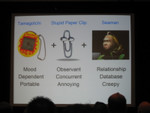
Then he put forth his goals. He wanted to have the mood dependency and portability of a Tamagotchi, the helpful/annoyance of Clippy, and the relationship and creepy aspects of seaman.
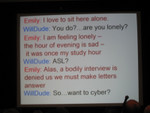 These interactions would include Instant Messaging, email, and interruptions while writing. Over time, the program would develop a model of behavior depending on how you'd interacted with it. Will's thought was that, while you could eventually get her to a stable state it was more likely that she'd become romantically obsessed with you, or suicidally depressive. In the latter case, he said, she would have the option of deleting herself off the USB drive.
These interactions would include Instant Messaging, email, and interruptions while writing. Over time, the program would develop a model of behavior depending on how you'd interacted with it. Will's thought was that, while you could eventually get her to a stable state it was more likely that she'd become romantically obsessed with you, or suicidally depressive. In the latter case, he said, she would have the option of deleting herself off the USB drive.
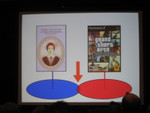
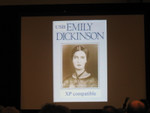
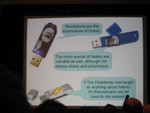
Scenarios? (Score:3, Interesting)
Comment removed (Score:2, Interesting)
digital clay (Score:3, Interesting)